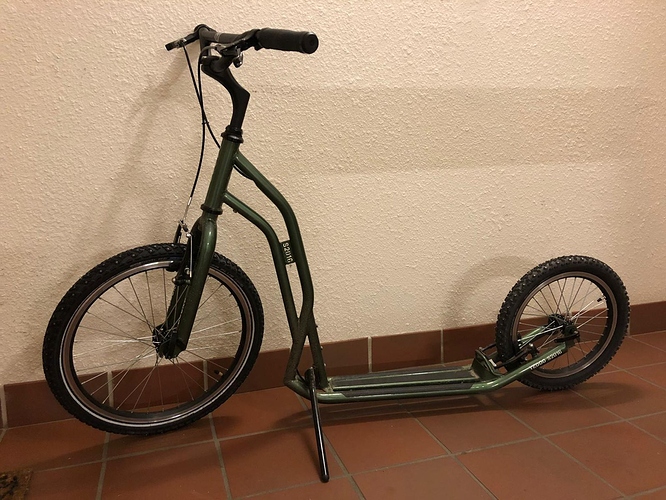Nah I’m sure you’re normal. He’s just a horribly fast learner.
Glad the tutorial I wrote all those years ago came in handy. Seeing how the streets are in the next month or so I am probably going to make another couple studded tires for my two wheeler.
I’m going to try the same screw from the inside technique but am going to attempt to run them tubeless with sealant and see how that goes. Hopefully the flexing of the studs doesn’t prevent them from sealing, but that’s what experimentation is for!
Edit: someone else has experimented before me and it sounds like it works tubeless if you glue the screws in place. I like experimentation, but I also like learning from other’s mistakes. This is why I love forums like this.
https://forums.mtbr.com/wheels-tires/diy-studs-tubeless-747736.html
I wouldn’t worry too much about it. I am not unique, there is a lot of variation in learning time and I have seen reports here of others who have learnt within hours, while others struggled for a very long time. Quite often it seems, those who learn fast are youngm as I was at the time.
It also seems to me that initial learning speed of the basics does not necessarily mean this progress will continue. Perhaps when it comes too easy at the beginning it is hard to muster motivation for more complex skills later. I still have a pretty basic skillset. Or perhaps we are all just different. ![]()
This was for the back wheel of a two-wheeler.
The back wheel is 16" (305mm rim). They do make studded tyres for 16" (349mm rim) but not that size. I had looked at the best grip style screw in studs but even the smallest were too deep for the tread on this tyre, so finally I decided to go with your original method.
P.S. I’ll admit I am doubtful about your tubeless idea but I really hope to be proved wrong, so that there is yet another option! ![]()
Interesting! Will check that out. Thanks!
This thread seems to be more about what wheels are best in snow than about technique as to how to traverse the snow. Now in one day we got about 20cm snow and I thought I go for a ride on the fatty (Hatched 26"), but as soon as I hop on, the wheel is basically locked and I can’t get enough strength to start going. Also the first 2 strokes I sway quite a lot and then the wheel slides and I step off again. Also tried with a bit of rolling after clearing away the snow a bit, but when the snow gets thicker, the wheel quickly locks up again.
I had the most luck with the KH 26, not a fatty, which is lighter and rolls easier. But starting off in thicker snow, I just don’t know how to do.
In one of the other threads Erlend Loe was riding his hatchet(?) in thick snow. Now I know more about how diffi it is.
Keep trying with momentum on your side.
Get your tire pressure as low as possible as a stiff wheel will dig in more and tend to sink.
Like riding on sand or mud, it’s unstable when riding slow but with good steady hard pressure on the pedals the ride will smooth out and be more predictable.
Go in with excess power as it’s easier to dump it than it is to gain it back.
As already mentioned, momentum and pressure are important. Snow is fun but also humbling.
I personally found useful also to use a synchronized hip movement forward to accompany the pedal stomping (a bit like when you want to roll over a small enough log).
Anyway, enjoy your sessions in snow no matter what you can do. Riding in snow (or trying to) really helped me realize all the possible subtleties of snow conditions (an why some polar-circle languages have so many words to describe snow  )
)
Riding in deep snow is very hard. It’s tiring and difficult, and TBH I don’t think it’s fun unless it’s powder and down hill. But when the snow is firm, usually after it’s been stomped down by hikers an bicyclists, it’s great. I ride a Hatchet, but you don’t need one to ride on firm snow. There are of course different degrees of ‘firm’, and when it’s semi hard the Hatchet is good. The riding technique is a little like riding steep hills. You have to stand up straight and try to keep your balance.
@Setonix I am bad at describing the physics of it and as the others have said, “snow” can vary massively, depending on factors like how icy, wet, dry, ‘fluffy’, compacted, and also how deep it is. This can also change over the course of a route, e.g roads can get cleared or salt can cause it to melt even when it is pretty cold. But what I can say is that like all things unicycling, it gets easier with practice and things that seem impossible initially can suddenly seem completely easy later on. Just get out there and go for it!
This ↑↑↑, so much this!
I will add one thing though, I do a lot of riding uphill on snow and that is about picking your line (based on understanding what snow you believe will hold) and keeping your speed and movements very consistent. Jerky movements and/or not avoiding slippery areas and you will not make it up.
